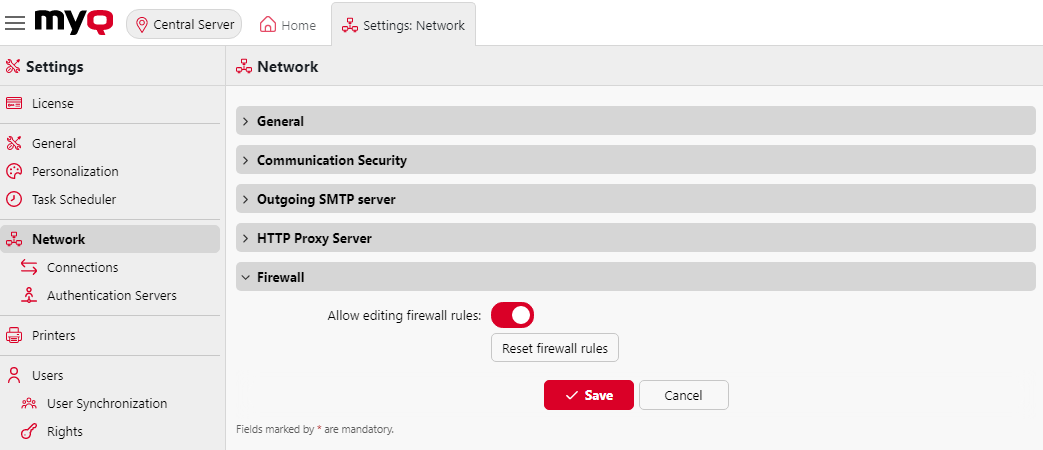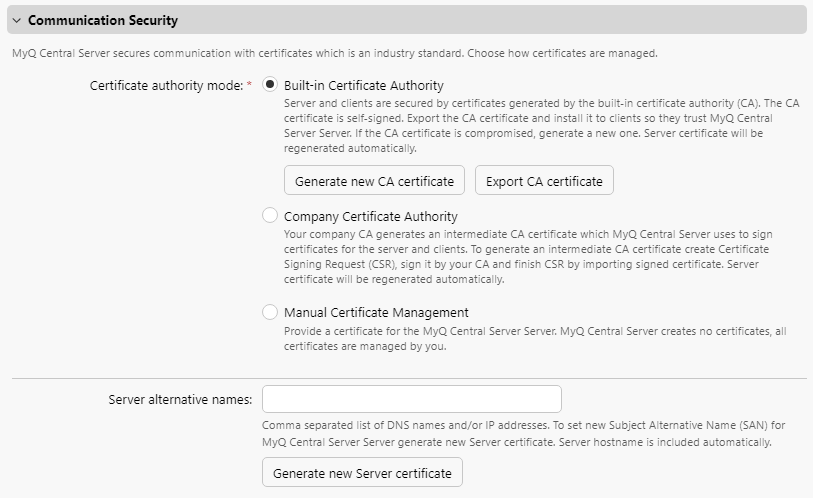Network Settings
On the Network settings tab, you can manage the network communication between the MyQ Central server and other parts of the MyQ solution. It is divided into the following sections: General, Communication Security, Outgoing SMTP server, HTTP Proxy server, and Firewall.

General
In this section, you can enter the hostname of the MyQ Central server. This hostname is used by external components of the MyQ system, such as the MyQ Replicator or Site servers, for communication with the MyQ Central server.
Communication Security
In this section, you can choose how your security certificates are managed.
MyQ offers three different certificate management modes:
Built-in Certificate Authority - This is the default mode for new installations. MyQ creates a self-signed CA certificate and uses it to sign server and client certificates. The public key of the CA certificate can be exported (click the Export CA certificate button) to install it to clients, so they trust MyQ server. It is possible to specify the Subject Alternative Name (SAN), which is set as a comma separated list of domain names and/or IP addresses. In case the certificate is compromised, click the Generate new CA certificate button, to generate a new one.
Company Certificate Authority - Your company CA generates an intermediate CA certificate which MyQ uses to sign certificates for the server and clients. To generate an intermediate CA certificate click Create CSR to create a Certificate Signing Request (CSR), sign it by your CA and click Finish CSR to finish CSR by importing signed certificate. If the intermediate CA certificate does not contain a CA root certificate in its chain, the administrator is prompted to upload the public key of the CA root certificate as well (the Import CA root certificate button appears).
Manual Certificate Management - Provide a certificate for the MyQ Server. MyQ creates no certificates; all certificates are managed by you. Click Import Server certificate to upload it. The certificate can be uploaded in PEM (public + private key separately) or in PFX format. The PFX format may be password encrypted. This mode is recommended only for expert users.

When upgrading an existing MyQ installation, the Certificate Authority mode is selected according to the existing server certificate:
if the certificate is not CA, then the mode is set to Manual Certificate Management.
if it was generated by MyQ before, then the mode is set to Built-in Certificate Authority.
in other cases, the mode is set to Company Certificate Authority.
Outgoing SMTP server
To send email reports, send error messages to users, send automatically generated PIN to users, and forward scanned documents, you have to configure the email server where all the emails are forwarded to.
To configure the server, do the following:
Select a Type from Classic SMTP Server, Microsoft Exchange Online or Gmail.
For Classic SMTP Server:
Enter the server hostname or IP address in the Server text box. If the email server listens to other than the 25 TCP port, change the Port setting to the correct value.
Choose between the Prefer StartTLS (default), Implicit TLS, and Require StartTLS Security options.
Optionally choose to Validate certificate or not.
If credentials are required, enter the User and Password.
Enter the address that you want to be displayed as the Sender email on PIN, alert and report messages.
After you enter the data, you can click Test to test the connection to the email server, and click Save to save your changes.
For Microsoft Exchange Online:
If you have already set up a Microsoft Exchange Online server in the Connections settings, the server is available in the Connections field drop-down. If not, you can click on the Connections field and then click Add new to add your Microsoft Exchange Online server connection. For more information, check Microsoft Exchange Online Setup.

If credentials are required, enter the User.
Enter the address that you want to be displayed as the Sender email on PIN, alert and report messages.
After you enter the data, you can click Test to test the connection to the email server, and click Save to save your changes.
For Gmail:
If you have already set up a Gmail server in the Connections settings, the server is available in the Connections field drop-down. If not, you can click on the Connections field and then click Add new to add your Gmail server connection. For more information, check Gmail with OAuth2 Setup.

If credentials are required, enter the User.
Enter the address that you want to be displayed as the Sender email on PIN, alert and report messages.
After you enter the data, you can click Test to test the connection to the email server, and click Save to save your changes.
HTTP Proxy Server
In this section, you can set up a MyQ Proxy server which can be used for activating a license. Mandatory fields are Server (name) and Port. After changing ports, restart all MyQ services.
Supported/Unsupported HTTP Proxy Services
Supported Services ![]()
Microsoft Azure Entra ID
Microsoft OneDrive for Business
Microsoft OneDrive Personal
Microsoft SharePoint Online
Microsoft Exchange Online
Gmail
Google Drive
Dropbox
Box
Amazon S3
License Server Communication
Unsupported Services ![]()
Microsoft Exchange (Local)
Payment Providers
Site → Central Communication
Central → Site Communication
Site → Terminals Communication
Firewall
In this section, you can Allow editing firewall rules of the Microsoft Windows Firewall and you can also Reset firewall rules.
.png)